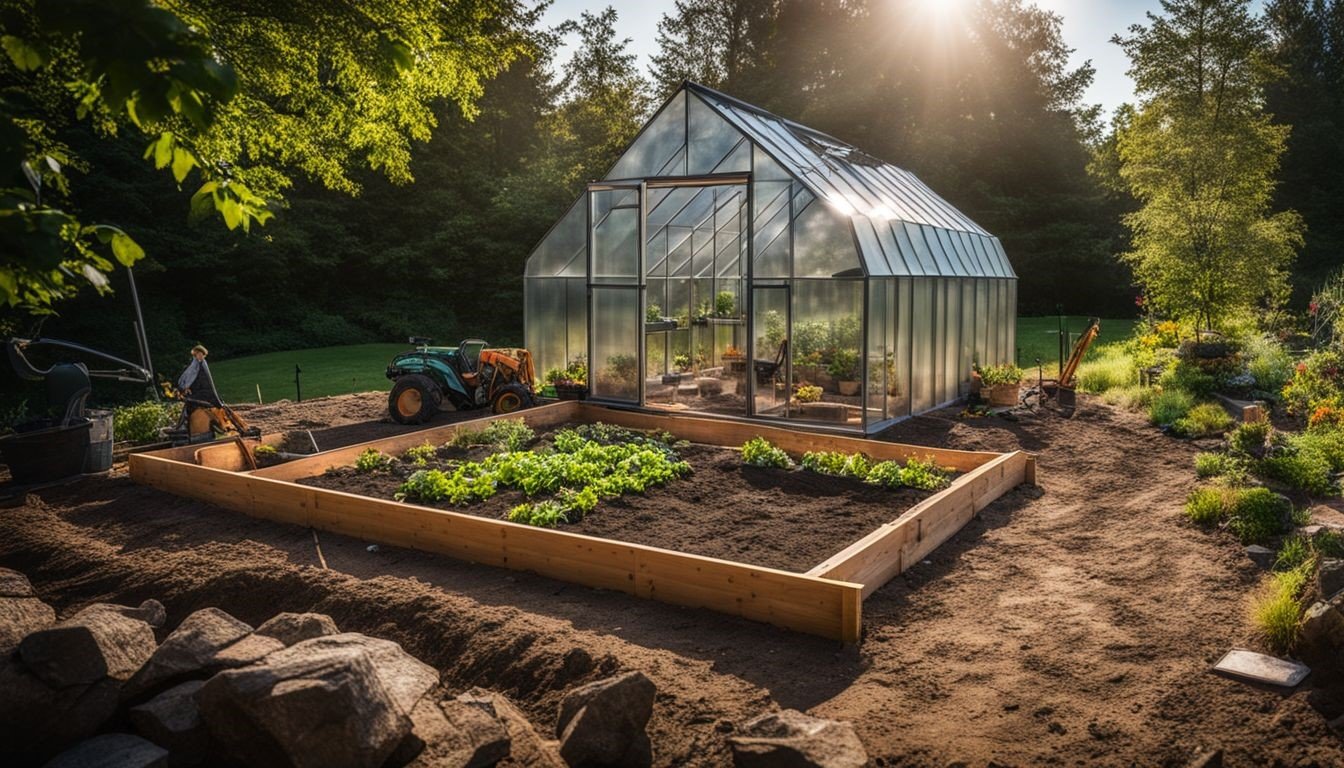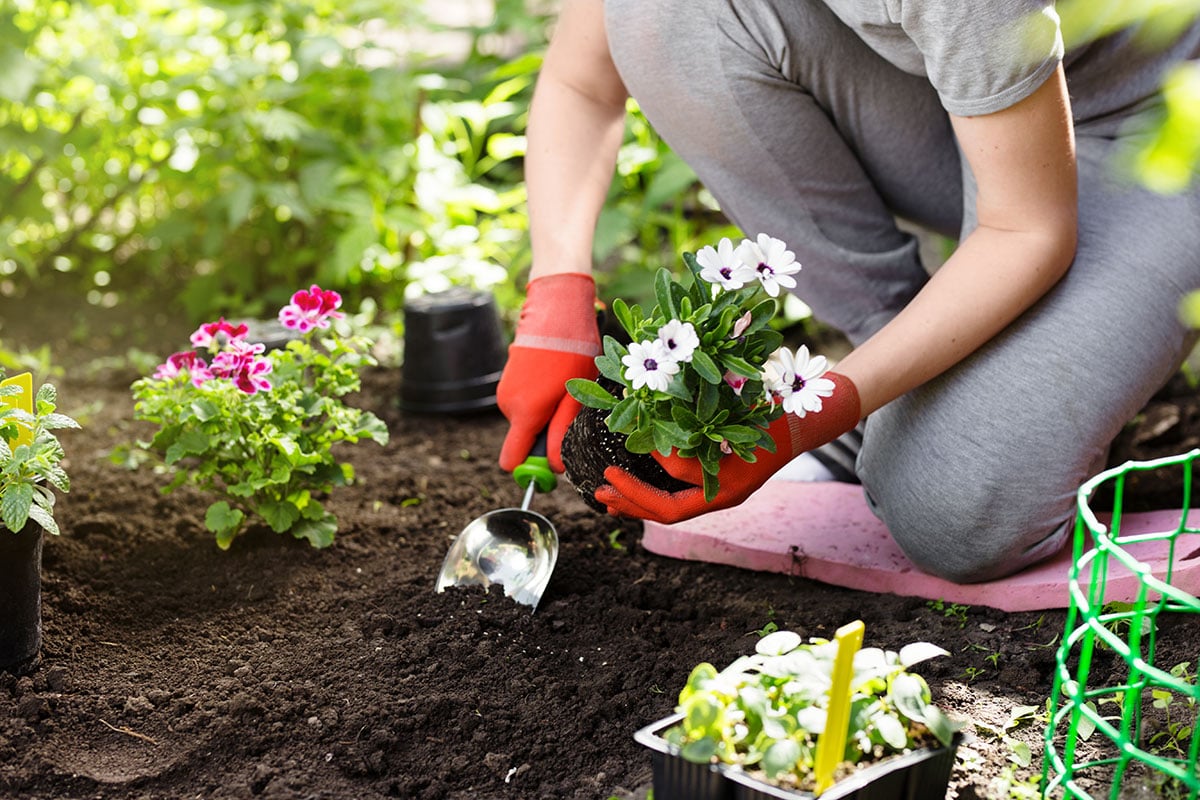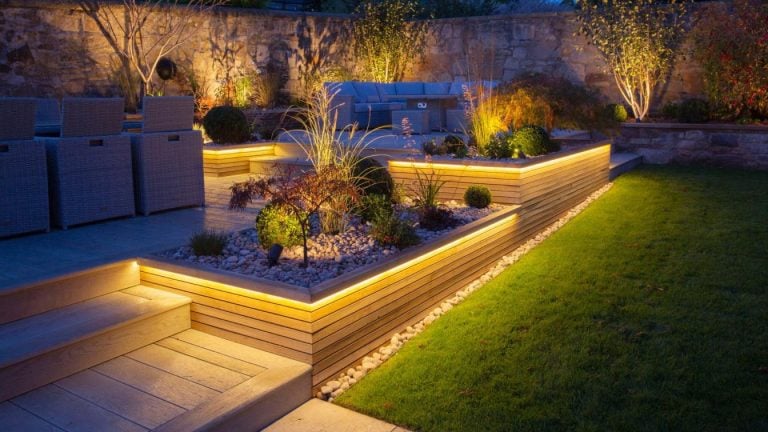Essential Guide to Building a Solid Greenhouse Foundation

Table of Contents
A solid foundation keeps your greenhouse steady and working well for years – dive deeper to find out how.
Ensures Stability and Longevity of The Greenhouse
Creating a solid foundation is key to keeping your greenhouse standing strong and lasting long. It fights against shifting soils and harsh weather, ensuring that everything from the frame to the glass remains secure.
Think of it as anchoring your greenhouse firmly to the ground, making sure that winds or heavy rains won’t tilt or move it.
This groundwork also extends the life of your greenhouse. With proper soil drainage and resistance against dampness, it prevents wood rot in wooden greenhouses and rust in metal ones.
By choosing durable materials like concrete slabs or pressure-treated lumber for foundations, you’re investing in years of thriving plants and successful harvests without constant repairs or replacements.
Facilitates Proper Assembly and Functioning of The Greenhouse
A solid foundation ensures the greenhouse fits together well. It lets each part of the structure meet and lock in place without a hitch. This means doors hang straight, windows fit snugly, and the whole building stands firm against wind and weather.
A precise foundation keeps your greenhouse level too. That’s crucial for water to drain correctly and for plants inside to grow strong.
With a solid base, owners face less hassle during assembly. There’s no need to fight with misaligned posts or struggle with uneven ground. Setting up becomes smoother, saving time and reducing stress.
This foundation also supports eco-friendly setups by holding cinder blocks or pressure-treated woods securely in place — all vital for sustainability and effective garden design.
Steps for Building a Solid Greenhouse Foundation
Laying the groundwork for your greenhouse starts with a careful plan and the right steps – think of it as setting the stage for years of lush, thriving plants. For all you need to know about this crucial process, keep reading!
Preparing the area
Clearing the area is your first step. Make sure you remove any weeds, rocks, or debris. This ensures your greenhouse base sits on smooth ground. Then, level the soil using a spade or auger.
It’s crucial for preventing water pooling and ensuring stability.
Next, use measuring tape to mark out the exact dimensions needed for your foundation. Accuracy here saves time later by avoiding misalignment of your greenhouse structure. Check that every corner forms a right angle to keep things square – a technique reminiscent of the Pythagorean theorem, (a² + b² = c²), comes in handy here!
Checking size and model
Before starting construction, make sure to check the greenhouse size and model. This step is crucial for ensuring that the foundation fits perfectly. Wrong measurements can lead to problems with assembly later.
Don’t forget – the type of greenhouse you’ve chosen impacts your ground preparation needs. Each model requires a different approach, whether it’s a concrete slab foundation or using paving slabs.
Matching the right base with your greenhouse ensures stability and longevity.
Assembling the foundation
Once you’ve got the right size and model for your greenhouse, it’s time to start assembling the foundation. This step is crucial for ensuring your greenhouse stands strong and lasts long.
You’ll begin by laying out all the pieces on a flat surface. Next, connect them together according to the instructions. Most foundations require bolts and nuts to secure each part firmly in place.
As you put everything together, keep checking that everything aligns correctly. Use a level to ensure the base is even because an uneven foundation can cause problems later on. Once assembled, you’re ready to move onto placing it in position—setting up a solid base marks the first step towards a stable and efficiently functioning greenhouse.
Placing it in position
Once the foundation is assembled, it’s time to move on to a pivotal phase—placing it in precise position. This step involves careful alignment according to the greenhouse’s size and model.
You must ensure every corner lines up just right. The process begins with marking where each corner will sit and drilling holes for expansion bolts. It’s crucial these bolts are placed accurately; they play a key role in anchoring your structure securely into place.
After securing the corners with bolts, take a moment to check everything is level. Use your spirit level here—it’s an invaluable tool for this task. Diagonal measurements also need checking to confirm the setup is square and true.
Following these checks ensures your greenhouse stands strong against winds and settles evenly without tilting or sinking over time. Now comes an exciting part—pouring cement around those anchor points you’ve so carefully prepared, encasing them in solid support once it sets completely.
Marking Corners
After you’ve placed the foundation in position, marking corners comes next. This step ensures every angle aligns perfectly for a stable greenhouse structure. You must be precise with this task—accuracy here affects everything from drilling holes to bending anchor bolts correctly.
It’s all about setting up for success; marked corners guide you toward assembling a level and sturdy foundation.
Use tools like measuring tape and pliers to get it right. Measuring both diagonally and straight ensures the area is squared off without any guesswork. A well-marked corner means anchor bolts will fit snugly, without forcing or adjustments later on during construction.
It’s these details that pave the way for a seamless assembly process, keeping your greenhouse standing strong through seasons.
Drilling Holes
Drilling holes is a key step in securing your greenhouse foundation. First, grab your spade or auger and start creating those holes at the marked spots. It’s straightforward—just make sure they’re the right depth for stability.
You’ll need measuring tape to check this, ensuring every hole matches up perfectly with your plan.
Next, it’s time to get those anchor bolts in place. Use pliers to adjust them if needed and a 10mm wrench comes in handy for any tricky bends. Don’t forget about the Juliana Start-Mix; it’s essential for bolstering those bolts inside the drilled holes.
This ensures everything stays put, exactly where you want it.
Checking Level and Diagonal Measurements
After making the holes, it’s time to focus on level and diagonal measurements. This step is key for ensuring a strong, level foundation right for your greenhouse. You’ll need a level, measuring tape, and a 10mm wrench.
First things first—place the level on various points of the foundation to check flatness across. Uneven spots could mean trouble later.
Next up, measure diagonally from corner to corner. Both distances should match exactly. If they don’t, adjust until they’re equal. This guarantees your foundation is square and ready for assembly.
These checks might seem simple but are crucial for avoiding pesky issues down the line. Take your time here—it pays off in stability and ease of greenhouse construction.
Pouring Cement
Pouring cement is a key step in securing your greenhouse’s foundation for stability and durability. First, mix the cement with gravel to get the right consistency—neither too thick nor too runny.
Make sure you have all necessary tools ready: a level, spade or auger, measuring tape, pliers, and of course, cement and gravel. Start by slowly pouring the mixture into the prepared area where holes have been drilled and anchor bolts bent into place.
Use a level to check that everything sits flatly across.
It’s crucial that once poured, you give the cement time to set properly before moving on—usually it needs about a day. This patience pays off as it ensures your greenhouse stands firm against weather and time.
Iron out any air pockets or uneven surfaces at this stage so you’re left with a solid base that’s ready for whatever comes next—be it placing frames or installing heaters for your plants.
Keep an eye on depth while pouring; not too shallow lest it lacks strength, nor too deep which wastes material—and don’t forget perimeter bases need careful attention to prevent future issues like water damage from drains failing.
By focusing on these details during the pour, you lay down more than just concrete; you establish a firm groundwork for green growth inside your sturdy new greenhouse.
Allowing it to set
After pouring the cement, it’s crucial to give it time to harden properly. This means waiting for at least a day before moving on with any further construction activities. The setting process is critical for ensuring that the foundation will be strong enough to support your greenhouse.
During this waiting period, avoid placing any weight or pressure on the surface. This patience pays off by forming a solid base that stands up against weather conditions and the test of time.
Tools Needed for Foundation Construction
For your greenhouse foundation, you’ll need a mix of simple and specialised tools. Gather everything from a spade to measure and level the ground, to cement and gravel for strength and stability.
Level
A level is your best friend in the construction of a solid greenhouse foundation. It’s essential for ensuring stability and longevity. Using a level helps make sure that all parts of the foundation are even, which supports proper assembly and functioning.
This simple tool plays a crucial role throughout the building process, from checking diagonal measurements to spreading cement and gravel evenly.
Having a level to hand means you can trust your greenhouse to stand firm against wind and weather, staying put for years to come. The Juliana Start-Mix might need this tool too, emphasising its importance across different stages of construction.
Make no mistake; skipping this step could lead to uneven ground or misaligned structures, inviting trouble down the line. A well-levelled base sets the stage for everything that follows in your greenhouse setup.
Cement
Cement is key for building a strong greenhouse foundation. It ensures the structure stands solid and stable over the years. Juliana Group suggests using Juliana Start-Mix, which might include cement, to make this task easier.
This mix works well with other tools needed for construction.
Pouring cement creates the base that your greenhouse needs to withstand various weather conditions. After mixing, you place it carefully where your foundation will be. Then, you give it time to set properly before moving on.
This step is crucial for a long-lasting and durable greenhouse that keeps pests out while keeping your plants safe inside.
Gravel
Gravel plays a crucial role in building a solid greenhouse foundation. It acts as a sturdy base, ensuring the foundation stays level and properly drained. This reduces the risk of water logging which can weaken the structure over time.
Using gravel also makes it easier to adjust the levels during construction. The Juliana Group, known for its high-quality products, advises incorporating gravel into your foundation setup for enhanced stability.
Next, you’ll need to prepare the area where your greenhouse will stand. This involves clearing any debris and ensuring a flat surface ready for construction.
Spade or Auger
After laying down the gravel, it’s time to focus on getting the ground ready for your greenhouse foundation. A spade or auger becomes crucial at this stage. These tools help you dig precise holes and trenches needed for a stable base.
Whether it’s creating space for poured concrete or setting up retaining walls, using a spade or an auger ensures that your groundwork is solid and ready for construction.
Digging with these tools allows for proper placement of foundations elements like bricks, screws, and washers. It’s essential not just for alignment but also helps in pest control by ensuring no gaps are left uncovered.
The effectiveness of these tools cannot be overstated—they transform challenging tasks into manageable steps in building a durable greenhouse foundation.
Measuring Tape
Moving on from digging tools like spades or augers, we get to the measuring tape. This tool is crucial for marking out your greenhouse foundation accurately. You need it to measure distances and ensure everything lines up correctly.
Without a measuring tape, you risk building a foundation that’s either too big or too small. The right size matters for both stability and efficiency.
A measuring tape allows you to check dimensions against your greenhouse model’s requirements. It helps avoid mistakes during assembly by ensuring each part fits as intended. Making sure your measurements are precise leads to a solid build—no wobbling or gaps where there shouldn’t be any! Keep in mind that accuracy at this stage lays the groundwork for the entire project’s success.
Pliers
After measuring everything out with your tape, you’ll need pliers to handle the next steps effectively. The Juliana Group recommends having a good pair of pliers on hand for foundation construction—it’s not just advice; it’s essential.
These versatile tools tighten and loosen bolts that hold the greenhouse frame firmly in place. They also come in handy for cutting or bending wires when securing parts together.
Pliers are critical for adjusting those hard-to-reach spots or clamping down on materials that need extra pressure. Without them, setting up your greenhouse could be much harder and take longer than necessary.
It’s all about making the assembly process smoother and ensuring everything is bolted down securely—exactly what you need to build a sturdy foundation for your greenhouse.
10mm Wrench
Moving on from pliers, a 10mm wrench becomes indispensable in building a solid greenhouse foundation. This tool is crucial for tightening and loosening nuts and bolts throughout the construction process.
Without it, ensuring stability and precise assembly of parts would be challenging.
The 10mm wrench plays a pivotal role, especially when working with specific models that require fine adjustments. Its use extends beyond just initial setup; maintenance tasks also often call for this versatile tool.
Keeping one handy ensures quick fixes and adjustments can be made efficiently, keeping your greenhouse standing strong and functional over time.






